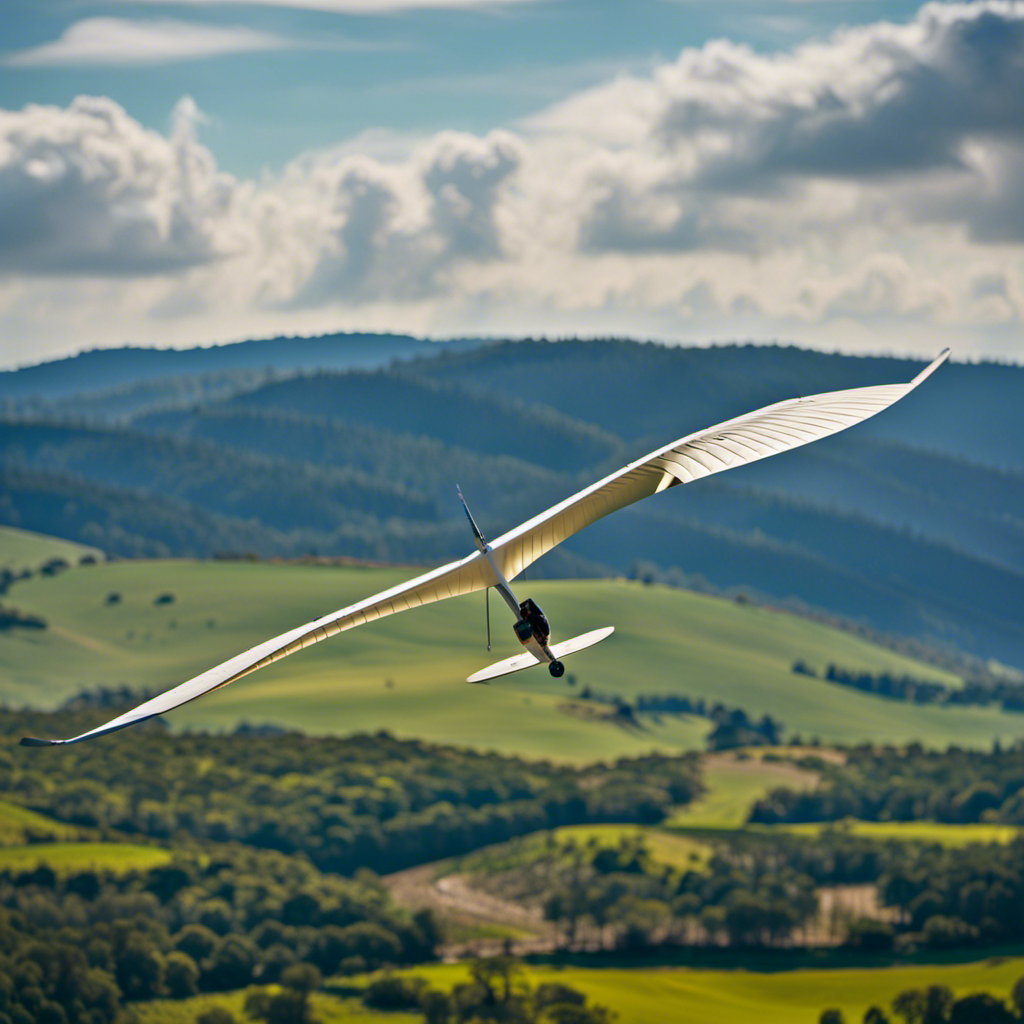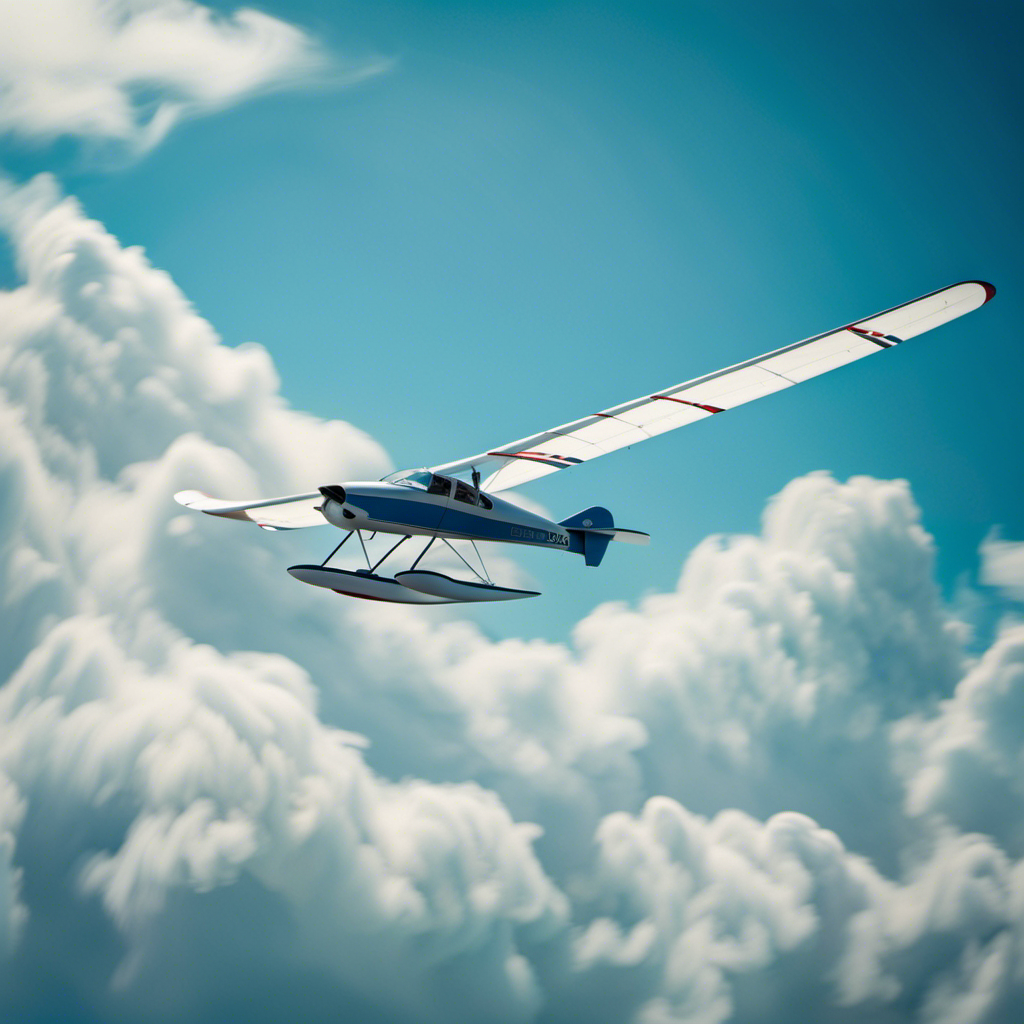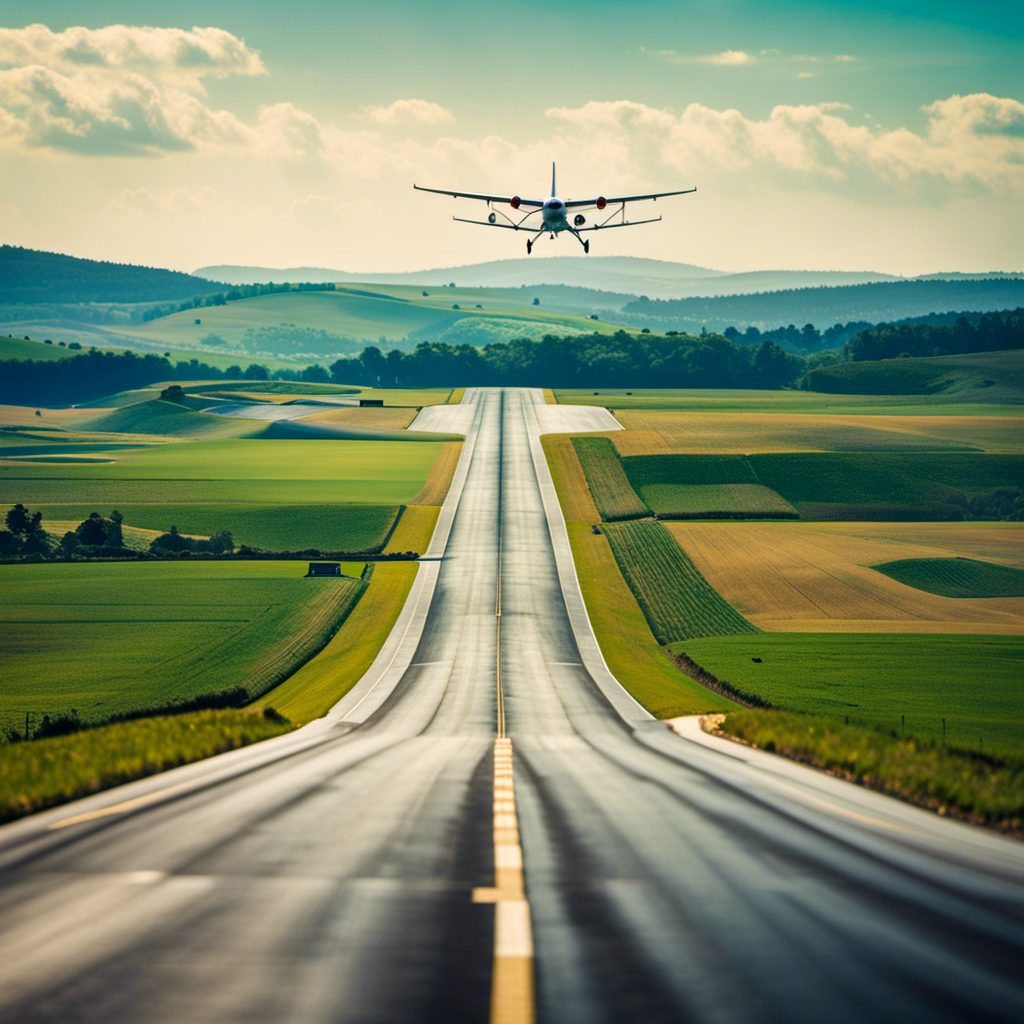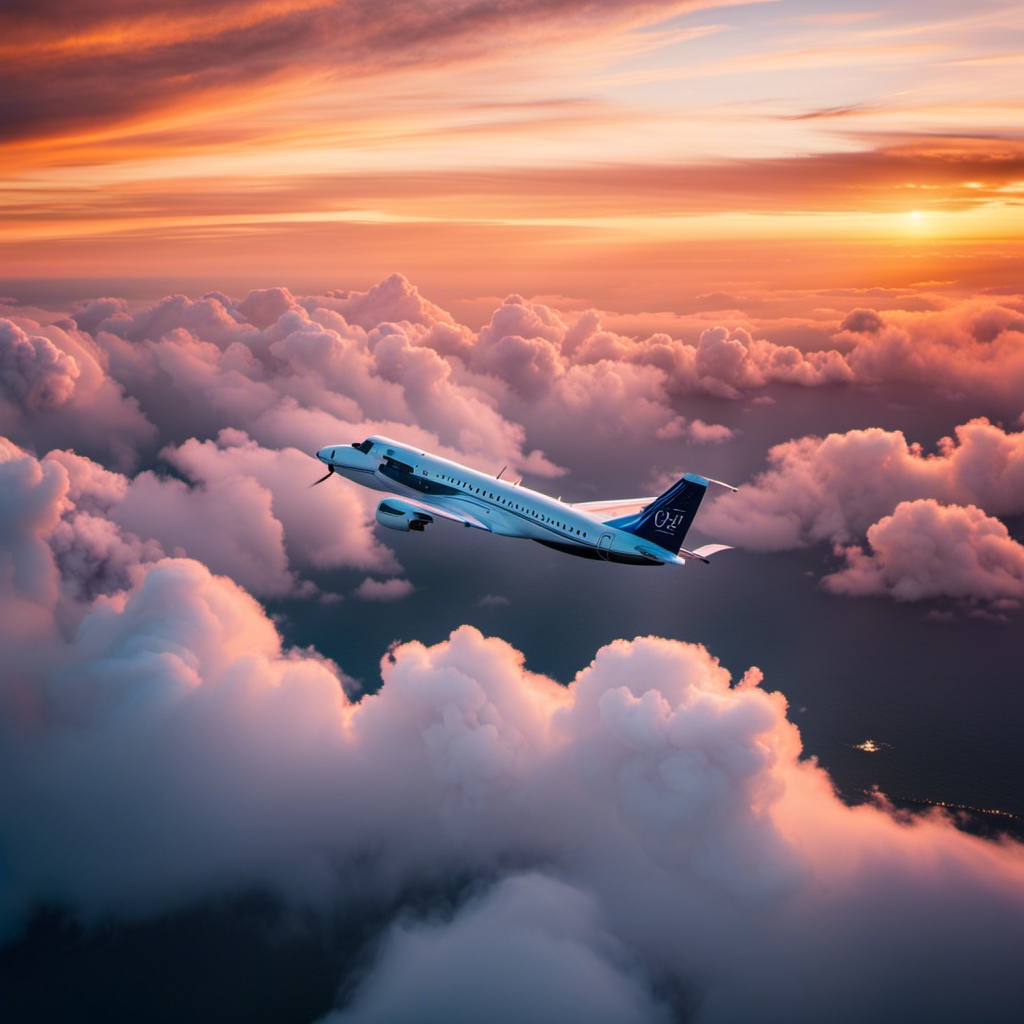The concept of flying and reaching out to touch the clouds has always captivated me. Were you aware that gliding offers an exciting and environmentally friendly method to experience the sensation of flight?
In this article, I’ll guide you through the basics of glider construction, teach you the fundamentals of gliding, and help you find a gliding school or club.
We’ll also dive into the world of gliding equipment, flight lessons, advanced skills, and connecting with the gliding community.
Get ready to embark on an incredible journey into the world of gliding.
Key Takeaways
- Understanding different materials used in glider construction and the importance of regular maintenance for safety and performance.
- Mastering weight shifting and understanding aerodynamics and weather patterns for controlling glider movements.
- Finding a reputable gliding school or club with experienced instructors and glider rental options.
- Connecting with the gliding community, participating in events and competitions, and embracing the eco-friendly and adventurous gliding lifestyle.
Understanding the Basics of Glider Construction
To understand the basics of glider construction, you’ll need to familiarize yourself with the different materials and components used.
Gliders are designed to take advantage of glider aerodynamics, allowing them to stay aloft without an engine. The main structure of a glider is typically made of lightweight materials, such as carbon fiber or fiberglass, to ensure maximum strength and minimum weight.
The wings play a crucial role in gliding, providing lift and stability. They are usually made of aluminum or composite materials.
Other important components include the cockpit, where the pilot sits, and the control surfaces, such as the ailerons and elevators, which allow the pilot to maneuver the glider.
Maintenance is also important to ensure the safety and performance of a glider. Regular inspections, cleaning, and following maintenance tips provided by the manufacturer are essential.
Understanding the basics of glider construction sets the foundation for learning the fundamentals of gliding.
Learning the Fundamentals of Gliding
Learning the basics of gliding can be an exciting and rewarding experience. To get started on this exhilarating journey, it is important to understand the fundamental learning techniques and safety precautions involved.
Here are some key points to consider:
-
Mastering the art of weight shifting: Learning how to shift your body weight effectively is crucial in controlling the glider’s movements.
-
Understanding aerodynamics: Knowing the principles of aerodynamics will help you make informed decisions during flight.
-
Practicing emergency procedures: Familiarize yourself with emergency protocols, such as how to handle a stall or a sudden loss of altitude.
-
Learning weather patterns: Understanding different weather conditions and their impact on gliding is essential for a safe and enjoyable experience.
-
Developing situational awareness: Being aware of your surroundings and constantly assessing your flight conditions will enhance your overall safety.
With these learning techniques and safety precautions in mind, it’s time to take the next step and find a gliding school or club where you can start your gliding journey.
Finding a Gliding School or Club
Finding a gliding school or club is an important step in starting your gliding journey. It’s crucial to find a reputable institution that offers professional training and resources.
One aspect to consider is the availability of glider rental options. Some schools or clubs may provide rental services, allowing you to practice your skills without having to invest in your own glider right away.
Additionally, finding the right gliding instructors is key. Look for experienced and certified instructors who can guide you through the learning process and provide valuable insights.
By choosing the right school or club and instructors, you’re setting yourself up for a successful gliding experience.
Next, let’s transition into getting familiar with gliding equipment.
Getting Familiar with Gliding Equipment
When it comes to gliding, it’s important to have the right equipment to ensure safety and a smooth flight.
This discussion will cover three key points: parachutes and safety gear, cockpit instruments and controls, and pre-flight inspections and maintenance.
These topics are essential for any glider pilot to understand and implement before taking to the skies.
Parachutes and Safety Gear
Parachutes are an essential component of safety gear in gliding. Proper parachute maintenance is crucial to ensure their effectiveness in case of emergency. Safety regulations require regular inspection and repacking of parachutes to guarantee their reliability.
As I prepare for my first gliding experience, I can’t help but imagine the importance of this piece of equipment. In my mind, I envision the following scenarios:
- A vibrant orange parachute, neatly folded and secured, ready to deploy when necessary.
- The satisfying click of the parachute harness as it fastens securely around my body.
- The rush of wind as I descend gracefully towards the ground, the parachute gently guiding my descent.
With the knowledge that parachutes are well-maintained and regulations are followed, I feel confident in my safety as I explore the next step of learning about cockpit instruments and controls.
Cockpit Instruments and Controls
After familiarizing myself with the importance of parachutes and safety gear in gliding, I turned my attention to the cockpit instruments and controls. These crucial components play a significant role in ensuring a safe and successful flight.
Instrument calibration is a key aspect of cockpit maintenance, as accurate readings are essential for making informed decisions during flight. From the altimeter that indicates the aircraft’s altitude to the airspeed indicator that displays the speed, every instrument must be calibrated to provide accurate information.
Additionally, cockpit ergonomics are vital for comfort and efficiency. Controls should be positioned within easy reach, allowing the pilot to make adjustments effortlessly. Comfortable seating and proper placement of instruments contribute to a pilot’s focus and overall flight experience.
With the cockpit instruments and controls properly maintained and ergonomically designed, it is time to move on to the next crucial aspect of gliding: pre-flight inspections and maintenance.
Pre-flight Inspections and Maintenance
Performing pre-flight inspections and maintenance is crucial for ensuring the safety and proper functioning of the aircraft before takeoff. To ensure pre-flight safety, pilots must diligently follow a maintenance checklist that covers various aspects of the aircraft.
This checklist includes inspecting the exterior of the aircraft for any signs of damage or wear, checking the engine oil and fuel levels, examining the control surfaces, and inspecting the cockpit instruments and controls. Additionally, pilots must ensure that all emergency equipment is present and in working condition.
By meticulously following these pre-flight procedures, pilots can identify any potential issues or malfunctions before taking to the skies, ensuring a safe and smooth flight.
Now that the aircraft is ready, it’s time to take flight lessons and learn the art of gliding.
Taking Flight Lessons
Before taking flight lessons, it’s important to familiarize yourself with the basic principles of gliding. Flight simulations are a great way to gain some initial experience and understanding of the controls and maneuvers involved in gliding. These simulations provide a safe environment to practice different scenarios and develop your skills before actually getting into the cockpit.
Once you feel comfortable with the simulations, it’s time to start taking flight lessons. A qualified instructor will guide you through the process, teaching you the essential techniques and safety procedures. They will also help you understand the effects of weather conditions on gliding, such as wind speed and direction, thermals, and cloud formations. Understanding these factors is crucial for a successful and safe flight.
With your newfound knowledge and skills, you will soon be ready to experience the thrill of soaring through the sky. The next section will delve into the exhilarating aspects of gliding, from the breathtaking views to the sense of freedom and adventure it brings.
Experiencing the Thrill of Soaring
Once you’ve mastered the essential techniques and safety procedures, you’ll be able to fully enjoy the exhilarating aspects of gliding, like the breathtaking views and the sense of freedom and adventure it brings.
Paragliding adventures take you soaring over mountains, allowing you to experience the thrill of being up in the sky. As you launch yourself into the air, the feeling of weightlessness takes over, and you become one with the wind.
The view from above is simply awe-inspiring, with the mountains stretching out below you and the vast expanse of the sky above. It’s a feeling like no other, as you glide effortlessly through the air, feeling the rush of adrenaline and the pure joy of flight.
Soaring over mountains during paragliding adventures is an experience that will leave you craving for more and longing to develop advanced gliding skills.
Developing Advanced Gliding Skills
To improve your gliding abilities, you’ll need to practice advanced techniques and master the intricacies of controlling your paraglider.
Advanced glider techniques are essential for those looking to take their gliding skills to the next level. These techniques include mastering weight shifting, understanding thermals and lift patterns, and perfecting your launch and landing techniques.
Additionally, developing cross country gliding strategies is crucial for those who wish to venture beyond the confines of the training slopes. This involves planning your flight path, utilizing wind currents, and optimizing your glide ratio to cover longer distances.
By honing these skills, you can explore new and exciting locations while enjoying the freedom of flight.
Now, let’s explore how connecting with the gliding community can further enhance your gliding journey.
Connecting with the Gliding Community
To fully immerse myself in the gliding community, I’ve found that attending glider events and meetups is a great way to connect with fellow enthusiasts and learn from their experiences.
Additionally, joining online gliding forums and groups allows me to engage in discussions, ask questions, and gain valuable insights from a wide range of gliders worldwide.
Lastly, networking with experienced gliders has been invaluable in expanding my knowledge and honing my skills. They offer guidance, mentorship, and share their expertise in the world of gliding.
Attending Glider Events and Meetups
Joining glider events and meetups is a great way for you to connect with other enthusiasts and learn more about the sport. Attending these events not only allows you to witness the breathtaking beauty of gliding in action but also provides an opportunity to engage with experienced pilots and gain valuable insights.
Here are a few reasons why attending glider events and meetups can be an emotional and fulfilling experience:
-
Sense of Community: Being part of a gathering where everyone shares the same passion creates a sense of belonging and camaraderie.
-
Inspiration: Watching skilled pilots maneuver their gliders with grace and precision can ignite a deep sense of awe and inspiration within you.
-
Learning Opportunities: Glider events often offer workshops, seminars, and demonstrations, allowing you to expand your knowledge and skills in the field.
-
Thrill and Excitement: Feeling the rush of adrenaline as you witness gliders soaring through the sky can leave you with an exhilarating feeling, fueling your own desire to take to the skies.
Attending glider events and meetups is just the beginning of your journey into the world of gliding. To further enhance your learning experience, joining online gliding forums and groups can provide a wealth of knowledge and resources.
Joining Online Gliding Forums and Groups
Being part of online gliding forums and groups can provide you with a supportive community of fellow enthusiasts who are eager to share their knowledge and experiences.
These online gliding communities serve as a platform for gliders from all over the world to connect and interact with one another.
Through these platforms, you can not only gain valuable insights and tips from experienced gliders but also share your own gliding experiences with others.
Whether you have a question about a specific technique or want to share a thrilling moment from your recent flight, these online forums and groups provide a space where you can connect with like-minded individuals who share your passion for gliding.
By joining these communities, you can expand your knowledge, learn from others, and build meaningful connections within the gliding community.
Networking with experienced gliders can further enhance your gliding journey and open doors to new opportunities.
Networking with Experienced Gliders
Networking with experienced gliders can greatly enhance your understanding of gliding techniques and provide valuable insights into the sport. By connecting with fellow gliders, you can learn from their experiences and gain valuable tips to improve your skills. Here are some ways to effectively network with experienced gliders:
-
Attend gliding events and competitions: These gatherings are perfect opportunities to meet and interact with experienced gliders who are passionate about the sport.
-
Join gliding clubs or organizations: Being a part of a gliding community allows you to meet experienced gliders who can mentor and guide you.
-
Participate in online gliding forums and groups: These platforms provide a space for gliders to share flight stories, exchange tips, and connect with one another.
-
Attend gliding seminars and workshops: These educational events often feature experienced gliders as speakers, providing you with a chance to learn from their expertise.
-
Volunteer at gliding schools or training centers: This allows you to work alongside experienced gliders, learning from them firsthand.
By networking with experienced gliders, you can build connections, gain knowledge, and grow as a glider.
Now, let’s explore some breathtaking gliding destinations.
Exploring Gliding Destinations
When it comes to gliding, there are plenty of breathtaking locations to explore. From soaring above the Swiss Alps to gliding over the Grand Canyon, scenic gliding locations offer a unique and thrilling experience.
Additionally, gliding holidays and tours provide an opportunity to immerse oneself in the gliding culture while enjoying the beauty of different destinations.
Lastly, international gliding competitions showcase the skill and talent of gliders from around the world, offering a chance to witness the excitement and competitiveness of this exhilarating sport.
Scenic Gliding Locations
There’s nothing quite like experiencing the breathtaking views at scenic gliding locations. Whether it’s soaring through the rugged peaks of mountain gliding or gliding along the tranquil coastlines, these locations offer a unique perspective that can’t be matched.
Mountain gliding provides a sense of adventure as you navigate through the majestic peaks, feeling the rush of wind against your face. The rugged terrain and vast landscapes create a truly awe-inspiring experience.
On the other hand, coastal gliding offers a serene and calming atmosphere. As you glide alongside the sparkling waters, you can enjoy the beauty of the ocean and the coastline from a whole new perspective.
These scenic gliding locations offer a range of experiences for gliding enthusiasts to enjoy. As you explore these breathtaking locations, you’ll be amazed at the stunning sights that await you on your gliding journey.
Gliding Holidays and Tours
Gliding holidays and tours offer a unique opportunity to explore stunning landscapes from a whole new perspective. Whether you are a seasoned glider pilot or a beginner looking to try something new, there are plenty of glider rental options available for your next adventure.
From soaring over picturesque mountains to gliding along breathtaking coastlines, the possibilities are endless. Imagine the thrill of flying through the air, surrounded by the beauty of nature, with nothing but the sound of the wind in your ears.
Gliding holidays and tours provide the perfect blend of excitement and tranquility, allowing you to immerse yourself in the wonders of the world from a bird’s eye view. And if you’re craving even more excitement, stay tuned for the next section where we’ll explore the world of international gliding competitions.
International Gliding Competitions
Imagine the excitement of participating in international gliding competitions and showcasing your skills to a global audience. These competitions bring together gliders from all over the world to compete in various events and challenges. To succeed in these competitions, participants must employ effective strategies and tactics to outperform their competitors. Let’s take a look at some common strategies and tactics used in international gliding competitions:
| Strategies | Tactics |
|---|---|
| Stay in Lift | Use thermal sources to gain altitude and stay airborne for longer durations. |
| Speed Optimization | Utilize speed-to-fly techniques to maximize glider performance and minimize drag. |
| Navigation | Plan efficient flight paths by analyzing weather conditions, wind patterns, and topography. |
| Risk Management | Assess and mitigate potential risks such as turbulence, airspace restrictions, and landing options. |
Embracing the Gliding Lifestyle
To fully immerse yourself in the gliding lifestyle, you’ll need to embrace the freedom of soaring through the sky. It’s a remarkable experience that not only allows you to connect with nature but also offers numerous benefits for your well-being.
Here are some reasons why embracing the gliding lifestyle can be a game-changer:
-
Living sustainably: Gliding is an eco-friendly activity as it relies solely on wind currents for propulsion, minimizing the carbon footprint.
-
Health benefits: Gliding requires concentration, coordination, and mental alertness, which can improve cognitive abilities and enhance overall mental health.
-
Stress relief: Gliding offers a sense of serenity and peace, allowing you to escape from the hustle and bustle of daily life.
-
Adventure and thrill: The adrenaline rush you get from gliding is incomparable, providing a unique and exhilarating experience.
-
Sense of achievement: Mastering the art of gliding can boost self-confidence and give you a sense of accomplishment.
Embracing the gliding lifestyle not only offers an environmentally friendly way of living but also promotes physical and mental well-being, making it an excellent choice for those seeking a fulfilling and exhilarating hobby.
Frequently Asked Questions
What are the specific safety regulations and requirements for gliding?
Gliding safety regulations include requirements such as obtaining a gliding pilot license, which typically lasts for a certain duration. These regulations ensure that pilots are trained and qualified to operate gliders safely, minimizing risks and ensuring the well-being of all involved.
Are there any age restrictions for learning gliding?
Age requirements for learning gliding vary depending on the country and the specific gliding school. However, in general, most gliding schools require students to be at least 14 or 16 years old to begin their training.
How long does it usually take to obtain a gliding pilot license?
Obtaining a gliding pilot license typically takes around 1-2 years. The process involves completing a certain number of flight hours, passing written exams, and demonstrating proficiency in various skills. Challenges include weather conditions and maintaining focus during long training sessions.
Is it possible to participate in gliding competitions as a beginner?
Participating in gliding competitions as a beginner is possible, like diving into a thrilling rollercoaster. There are gliding competitions specifically designed for beginners, providing a great opportunity to showcase skills and learn from experienced pilots.
Are there any specific medical conditions that could prevent someone from learning gliding?
Specific medical conditions, such as heart problems, epilepsy, and severe vision impairment, may prevent someone from learning gliding. Eligibility criteria often include obtaining medical clearance and being free from physical limitations that could compromise safety.
Conclusion
Well, who would’ve thought? I never imagined myself soaring through the sky like a bird. But here I am, embracing the gliding lifestyle and touching the clouds.
Learning gliding was a journey that took me through the basics of construction, the fundamentals of flying, and connecting with a vibrant community. It’s ironic how something so serene and peaceful can also be exhilarating and thrilling.
So if you’re looking for a new adventure that defies gravity, give gliding a try. You won’t regret it.
With a heart that soars as high as the skies, Aria, affectionately known as “Skylark,” is the driving force behind Soaring Skyways. Her journey into the gliding world began as a young dreamer gazing up at the soaring birds, yearning to experience the weightlessness and freedom they embodied. With years of experience both in the cockpit and behind the scenes, Aria’s commitment to the gliding community is unwavering.










